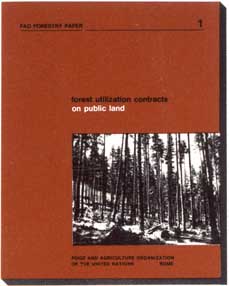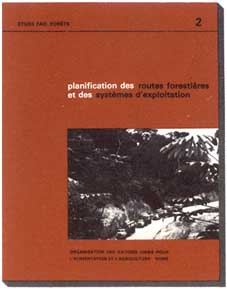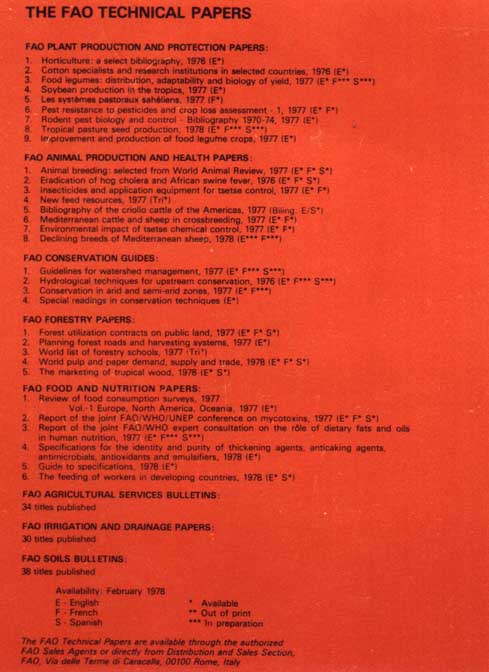Eating the right leaves in a tropical forest
References
Using people to build roads is not easy
Edible Leaves Or the Tropics, by Franklin W. Martin and Ruth M. Ruberte. Mayaguez Institute of Tropical Agriculture, P.O. Box 70, Mayaguez, 00708 Puerto Rico, 1975. Published jointly by the Agency for International Development, Department of State, and the Agricultural Research Service, U.S. Department of Agriculture, pp. vii + 235, 56 figures, 12 tables. Appendix. Index.
Edible Leaves of the Tropics is a most interesting and useful book, but it is also potentially dangerous.
A quick picture of what it contains may be had from the chapter headings. Following an introductory chapter the book covers:
· The principal edible green-leaf herbs of the tropics.
· Some fruits, vegetables and ornamental plants that also bear edible leaves.
· Common weeds with edible green leaves.
· Tropical trees with edible green leaves.
· Tropical leaves as spices and teas.
· Temperate zone green leaves in the tropics.
· Lettuce in the tropics.
· Tropical leaves that are poisonous.
· Culture and care of green-leafed vegetables.
The following are treated in a class of principal edible green-leaf herbs: various species of Amaranthus, New Zealand spinach, the leaves of cocoyams (Colocasia and Xanthosoma), Ceylon spinach (Basella rubra), sweet potato and Knagkong (Ipomoea aquatica), water cress (Nasturtium officinale), the fluted gourd (Telfairia occidentalis), cassava (Manihot esculenta), various Hibiscus species, water leaf (Talinum triangulare), and Corchorus olitorius. Also included in the list of major species which will come as a surprise to many, is Sauropus androgynus, the Katuk of India and Malaysia. A significant error in this chapter is the statement that "some varieties of Amaranthus are purplish with antho-cyanin. This is not so, Amaranthus and most members of the Centro-sperm order do not have antho-cyanin pigments but betalain alkaloid pigments (1).
In the chapter on fruits, vegetables and ornamental plants that bear edible leaves, the reader is left with a considerable feeling of unhappiness about the possible consequence of too much experimentation following the reading of this book. For example, page 37, "there is no reason that once carrots have been purchased with tender, edible leaves that these should be discarded in favour of the roots. However, young leaves cause dermatitis to sensitive persons. "And on the same page, under eggplant" as is frequently the case, the leaves, which are seldom used but which are perfectly edible, are more nutritious than the fruits... the fine hairs of the leaf are irritating to many people." On page 39 it is pointed out that the young leaves of Euphorbia purcherrima, the common Poinsettia "are not only edible, but highly nutritious." However, in the same paragraph it is warned that the latex is sufficiently caustic to remove hairs from the body, that the gathering of leaves may lead to dermatitis, and futhermore because it is poisonous, the plant should be kept from children who are apt to chew it. On page 41 a very dangerous idea is set out with reference to the genus Spondias. "It is known that a number of species of Spondias bear edible fruits and it is probable that the leaves of all species are edible." While this may be true, it is a rather rash statement which might tempt people into unsafe experiments.
The danger of transferring belief in edibility from one species to another within a genus should be well known from consideration of Solanum, though it is rather surprising that in this book it is pointed out that the young leaves of both potatoes and tobacco are edible. Of young tobacco leaves the authors suggest "the amount normally used for a cooked dish should not be harmful." Less well-known however than the example of the dangers of widespread eating of the leaves of Solanurn would be the genus Phyllanthus (Euphorbiace). On page 41 it is pointed out that two species of this genus bear edible fruits and leaves. These are the Otaheite gooseberry (P. acidus) and also P. emblica. However, Phyllanthus engleri Pax and P. reticulatus Poir are both included in Verdcourt and Trump's very valuable book on the common poisonous plants of East Africa (2). They report that a man is recorded as having died within 12 hours after eating three leaves of Phyllanthus engleri. Admittedly, the record is open to some doubt.
The chapter on common weeds with edible green leaves is a fascinating one. The first question that the reader will ask himself is "When is a weed not a weed?" The very concept of a weed is one from modern agriculture in which crops are planted in pure stands and anything in an area occupied by the crop that is not intended to be growing there can be regarded as a weed. But in less developed agriculture mixed cropping is common and plants may grow more or less at random. Is a wild plant that has seeded itself but is nevertheless tended and valued as a food crop a weed or not? Among the plants which these authors regard as being weeds are the purslane, Portulaca oleracea. This is certainly sown and cultivated as a crop plant in some countries, and some special varieties have been selected. So much for detailed criticism, though one could continue.
What is very valuable about this book is that there is some prospect that it may help to make the continued cultivation and use of indigenous vegetables, which are well-known to the inhabitants of developing countries respectable. Attempts to replace the eating of Calaloo in the West Indies or Dodo in East Africa by white fleshed, hearty cabbages of much lower nutritional value, may have aggravated nutritional problems in some countries. There has been a welcome trend during the last 10 years for agriculturalists of temperate-zone training to take a more enlightened attitude toward local tropical vegetables, and the present book is a symptom of this trend. On the question of safety, perhaps the best advice which can be given would be the same as for the eating of local mushrooms. Find out what the local people, and particularly the older ones who may be more familiar with customary diet, consider edible. Test its nutritional value and encourage the continuing of its production and use if there are no counter indications.
This is a provocative and important book in spite of any anxieties that it may engender in the minds of readers. It deserves to be widely read by agriculturalists, nutritionists and development planners. It will help to open the eyes of very many people to prospects for the production of food of which they have never dreamed.
C.L.A. LEAKEY
Appropriate Technology, London
1. MABRY, T.J. Pigment dichotomy and NDA-RNA Hybridization data for Centrospermous families. In Evolution of centrospermous families. Mabry, T. M. and Dietmar Behnke, H. (Eds.) Springer-Verlag, Wien, New York. 1976
2. VERDCOURT, B. and TRUMP, E.C. Common poisonous plants of East Africa. Collins, London. 1969
Manual on the planning of labour-intensive road construction, by M. Allal and G.A. Edmonds in collaboration with A.S. Bhalla. International Labour Office CH 1211, Geneva 22, Switzerland, 1977. 40 Swiss Francs, 253 pp. Soft cover.
The visitor to Geoff Edmonds' office in Geneva immediately notices a small white card pinned to the wall in front of his desk. It reads:
"Any socio-economic phenomenon which cannot be described in plain English but must be described in algebraic notation, is not worth describing at all!"
He practices what the card preaches, since this book is an example of clear and well-argued propositions on a topic which is of crucial interest to the developing world. Anyone who has visited some of the excellent (and appropriate) earth roads being constructed in Kenya under the rural access roads programme will also know that this ILO team has real experience of applying intermediate technology.
The first two chapters of the book cover road planning and road design. Indeed, it is often at these early stages that "the pass is sold" on the possibility of labour-intensive methods being economic in the conventional sense. For example, it is often possible to choose between a number of possible routes from A to B. By choosing a route which avoids hauling earth over long distances and other activities which are difficult for hand labour, labour-intensive methods can often compete in conventional accounting terms as well as being socially beneficial.
In later chapters the authors deal comprehensively with the key areas of cost and productivity. Two men doing one man's work is not intermediate technology, it is plain inefficiency. Although the case for labour-intensive methods does not rest on cost and efficiency comparisons alone, it would certainly benefit from the availability of more hard data and rigorous analysis.
The second part of the book discusses the institutional setting as a background to the appraisal of technologies. After discussing various fiscal and administrative measures which can help to create a more favourable environment for labour-intensive techniques, the authors go on to cover the problems of organization and management posed by the larger labour forces associated with intermediate techniques.
The authors rightly point to the "distinct lack of training" in this sort of management which should be regarded as being an integral part of the duties of a public works department. Special courses are needed and these should be directly related to the projects on which the trainees will subsequently work.
A short final chapter underlines the serious constraint on the application of intermediate techniques which results from the attitude of engineers who often preclude the choice of technologies appropriate to their own environment and social problems. The "one-solution-to-one-problem attitude" is rightly castigated, and it seems sad that the challenge of operating efficiently with labour-intensive methods (which are in reality more demanding in terms of professional skill) is so seldom emphasized in courses both inside and outside developing countries.
Although the price of this volume (40 Swiss francs) may seem high, the book certainly represents a major step forward in the national and human assessment of road construction technologies. Ministries, development agencies and consultants should buy it - and read it!
among the FAO technical papers...
a continuously expanding list of studies dealing with specific problems of forestry. Many of these papers are available in all three languages - English, French and Spanish. All are available, on payment of handling charges, from the Distribution and Sales Section, FAO, Via delle Terme di Caracalla, 00100, Rome; or through the authorized sales agents and booksellers listed on the inside back cover.
FAO FORESTRY PAPERS



